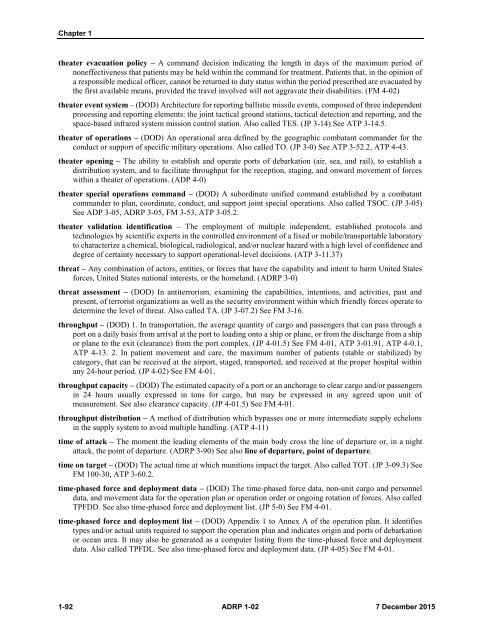ADRP1-02
52543f77c16bcfa46f6e1de2B038ef195
52543f77c16bcfa46f6e1de2B038ef195
Create successful ePaper yourself
Turn your PDF publications into a flip-book with our unique Google optimized e-Paper software.
Chapter 1<br />
theater evacuation policy – A command decision indicating the length in days of the maximum period of<br />
noneffectiveness that patients may be held within the command for treatment. Patients that, in the opinion of<br />
a responsible medical officer, cannot be returned to duty status within the period prescribed are evacuated by<br />
the first available means, provided the travel involved will not aggravate their disabilities. (FM 4-<strong>02</strong>)<br />
theater event system – (DOD) Architecture for reporting ballistic missile events, composed of three independent<br />
processing and reporting elements: the joint tactical ground stations, tactical detection and reporting, and the<br />
space-based infrared system mission control station. Also called TES. (JP 3-14) See ATP 3-14.5.<br />
theater of operations – (DOD) An operational area defined by the geographic combatant commander for the<br />
conduct or support of specific military operations. Also called TO. (JP 3-0) See ATP 3-52.2, ATP 4-43.<br />
theater opening – The ability to establish and operate ports of debarkation (air, sea, and rail), to establish a<br />
distribution system, and to facilitate throughput for the reception, staging, and onward movement of forces<br />
within a theater of operations. (ADP 4-0)<br />
theater special operations command – (DOD) A subordinate unified command established by a combatant<br />
commander to plan, coordinate, conduct, and support joint special operations. Also called TSOC. (JP 3-05)<br />
See ADP 3-05, ADRP 3-05, FM 3-53, ATP 3-05.2.<br />
theater validation identification – The employment of multiple independent, established protocols and<br />
technologies by scientific experts in the controlled environment of a fixed or mobile/transportable laboratory<br />
to characterize a chemical, biological, radiological, and/or nuclear hazard with a high level of confidence and<br />
degree of certainty necessary to support operational-level decisions. (ATP 3-11.37)<br />
threat – Any combination of actors, entities, or forces that have the capability and intent to harm United States<br />
forces, United States national interests, or the homeland. (ADRP 3-0)<br />
threat assessment – (DOD) In antiterrorism, examining the capabilities, intentions, and activities, past and<br />
present, of terrorist organizations as well as the security environment within which friendly forces operate to<br />
determine the level of threat. Also called TA. (JP 3-07.2) See FM 3-16.<br />
throughput – (DOD) 1. In transportation, the average quantity of cargo and passengers that can pass through a<br />
port on a daily basis from arrival at the port to loading onto a ship or plane, or from the discharge from a ship<br />
or plane to the exit (clearance) from the port complex. (JP 4-01.5) See FM 4-01, ATP 3-01.91, ATP 4-0.1,<br />
ATP 4-13. 2. In patient movement and care, the maximum number of patients (stable or stabilized) by<br />
category, that can be received at the airport, staged, transported, and received at the proper hospital within<br />
any 24-hour period. (JP 4-<strong>02</strong>) See FM 4-01.<br />
throughput capacity – (DOD) The estimated capacity of a port or an anchorage to clear cargo and/or passengers<br />
in 24 hours usually expressed in tons for cargo, but may be expressed in any agreed upon unit of<br />
measurement. See also clearance capacity. (JP 4-01.5) See FM 4-01.<br />
throughput distribution – A method of distribution which bypasses one or more intermediate supply echelons<br />
in the supply system to avoid multiple handling. (ATP 4-11)<br />
time of attack – The moment the leading elements of the main body cross the line of departure or, in a night<br />
attack, the point of departure. (ADRP 3-90) See also line of departure, point of departure.<br />
time on target – (DOD) The actual time at which munitions impact the target. Also called TOT. (JP 3-09.3) See<br />
FM 100-30, ATP 3-60.2.<br />
time-phased force and deployment data – (DOD) The time-phased force data, non-unit cargo and personnel<br />
data, and movement data for the operation plan or operation order or ongoing rotation of forces. Also called<br />
TPFDD. See also time-phased force and deployment list. (JP 5-0) See FM 4-01.<br />
time-phased force and deployment list – (DOD) Appendix 1 to Annex A of the operation plan. It identifies<br />
types and/or actual units required to support the operation plan and indicates origin and ports of debarkation<br />
or ocean area. It may also be generated as a computer listing from the time-phased force and deployment<br />
data. Also called TPFDL. See also time-phased force and deployment data. (JP 4-05) See FM 4-01.<br />
1-92 ADRP 1-<strong>02</strong> 7 December 2015


